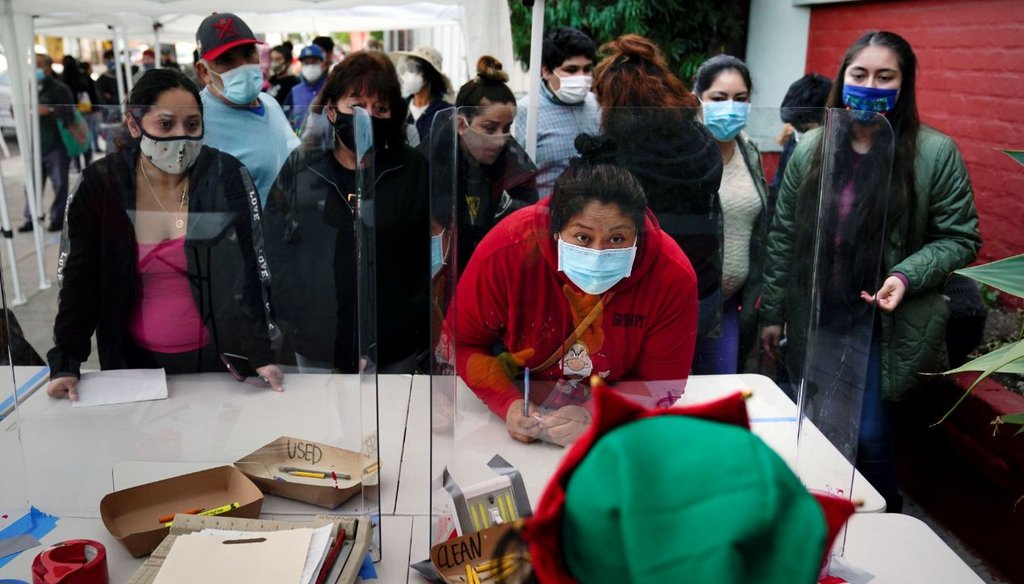Stand up for the facts!
Our only agenda is to publish the truth so you can be an informed participant in democracy.
We need your help.
I would like to contribute

People check in at a food bank at a Los Angeles Boys & Girls Club on Dec. 17, 2020. (AP)
If Your Time is short
• President Joe Biden said his proposal to increase the $2,000 child tax credit and expand it to more families would cut child poverty by half.
• Experts said the analyses undergirding Biden’s assertion are credible, though it’s worth noting that the drop in child poverty would only last for one year under the current proposal, and that there are always reasons for uncertainty when evaluating the effects of policy changes.
President Joe Biden and others in his administration have said it repeatedly and definitively: Pass the coronavirus relief bill and child poverty will be cut in half.
Biden said it on Feb. 23, when he hosted Black essential workers for a roundtable at the White House. Referring to the refundable child tax credit that’s part of his relief proposal, Biden said, "If we get this done, it will cut child poverty in half." And Biden’s press secretary, Jen Psaki, offered a similar assertion in three separate briefings.
We can’t fact-check a prediction. But given its frequency as a White House talking point, we decided to dig into Biden’s child tax credit proposal and the evidence to support the notion that it would decrease child poverty by half.
What’s in Biden’s proposal?
Biden’s idea builds on an existing $2,000 child tax credit but expands it for lower- and middle-income families. The idea is that this additional monthly income would push many American families over the poverty line.
The legislative language isn’t final — the broader relief bill remains to be negotiated in the House and Senate.
The version of the proposal included in Biden’s American Rescue Plan would include a one-year increase of the child tax credit to $3,000 per child (or $3,600 for a child under age 6). It would also extend to 17-year-olds during that year. Ordinarily, children have to be under 17 to be claimed for the credit.
A bill introduced in the House that could be a starting point for negotiations hews closely to Biden’s model. It would phase out the benefit for individuals earning at least $75,000 a year and couples earning at least $150,000 a year. The IRS would send the payments to families eligible to receive the refundable credit on a monthly basis, similar to how last year’s coronavirus stimulus payments were handled.
The poverty level used by the analysis is an annual income of $28,000 for a two-parent, two-child family in an average-cost city.
"Of all the policy issues being discussed this Congress, of all the things we are working on, the biggest impact we can make for economic justice in our country — and enact measurable transformational change — lies within this policy that would slash child poverty," Sen. Cory Booker, D-N.J., told The Washington Post.
The idea of expanding the child tax credit has won support mostly from congressional Democrats like Booker, but some Republicans say they’re open to more aid for families with children. Sen. Mitt Romney, R-Utah, has offered a proposal for direct cash payments to families, though it would cut other aid to low-income families, which the Democratic proposals would not do. Sen. Marco Rubio, R-Fla., and a few other Republicans have also expressed openness to negotiations on an expanded child tax credit.
Why does Biden think it will cut child poverty in half?
The White House did not respond to an inquiry, but the primary evidence usually cited by backers is an analysis by Columbia University’s Center on Poverty and Social Policy published Jan. 14.
According to the analysis, Biden’s proposal would cut the overall poverty rate to 9% from 12.6%, and by larger amounts for some subgroups. For children, the poverty rate would fall to 6.6% from 13.4%, which is where the "cut by half" language comes from. For Black families, it would fall to 13.3% from 20.3%. Hispanic families would see the largest decline of all, from 18.9% to 11.4%.
Poverty policy specialists told PolitiFact that the Columbia analysis was solid. "Biden is citing highly credible academic estimates, so in the context of a non-technical speech, we would consider the statements to be straightforwardly correct," said Arloc Sherman, vice president of data analysis and research at the liberal Center for Budget and Policy Priorities.
Take notice of the fine print
Experts across the ideological spectrum said Biden’s framing of the proposal and the supporting research is reasonable. However, experts added that there are a few nuances in Biden’s proposal and the analysis that don’t always come across in the White House’s public statements. Here are three:
It’s more accurate to say the proposal "could" cut child poverty in half rather than "would."
While Biden said at the roundtable that the plan "would" cut child poverty in half, the supporting analysis from Columbia used the term "could," allowing for some uncertainty.
"Our analysis suggests that it ‘would,’ but of course, nothing is certain in this world or this life," said Christopher Wimer, one of the Columbia report’s co-authors.
The projected decline in poverty isn’t just because of the child tax cut expansion.
Biden’s comments at the roundtable referred to the child tax credit. But the Columbia analysis also factored in several other parts of Biden’s proposal when determining the cut in the poverty rate, including an extension of food stamp increases, additional stimulus payments, and an extension of expanded unemployment insurance.
A separate analysis by the Columbia group looked at just the child tax credit expansion and found that it would cut child poverty by about 45%, which is not quite half.
Another study by the conservative American Enterprise Institute found that the child tax credit proposal would reduce child poverty by 35%.
The cut in child poverty may not last more than a year.
Biden’s proposal would expand the child tax credit only for 2021. Extending it beyond a year would require further action by Congress.
"That said, Democrats are clearly intending to try to make the child tax credit expansion permanent," said Scott Winship, director of poverty studies at the American Enterprise Institute. "Whether that would produce a permanent decline in child poverty depends a lot on the longer-term effects on work, marriage and fertility, among other factors."
He said that many academic models, including Columbia’s, don’t include possible behavioral effects of policy changes, such as potential reductions in work or increases in single parenthood. "Those are probably more important as longer-term effects, but they still could matter," he said.
All in all, enacting Biden’s proposal would be a positive step against child poverty, said Timothy M. Smeeding, a professor of public affairs and economics at the University of Wisconsin's Robert M. La Follette School of Public Affairs.
"It would make incomes and families more stable, have strong positive effects on kids’ long-term outcomes," Smeeding said, and "would be clear, visible evidence that government can actually help families every month."
Our Sources
White House, remarks by President Biden in a roundtable with Black essential workers moderated by Domestic Policy Advisor Susan Rice," Feb. 23, 2021
Columbia University Center on Poverty and Social Policy, "The Potential Poverty Reduction Effect of President-Elect Biden’s Economic Relief Proposal," Jan. 14, 2021
Columbia University Center on Poverty and Social Policy, "A Poverty Reduction Analysis of the American Family Act," Jan. 25, 2021
National Academies, "A Roadmap to Reducing Child Poverty," 2019
American Enterprise Institute, "The Tax Benefits of Parenthood," February 2021
Washington Post, "Senior Democrats to unveil $3,000-per-child benefit as Biden stimulus gains steam," Feb. 7, 2021
Los Angeles Times, "Overlooked in Biden’s COVID-19 relief plan: A push to cut child poverty in half," Feb. 5, 2021
Email interview with Arloc Sherman, vice president of data analysis and research at the Center for Budget and Policy Priorities, Feb. 24, 2021
Email interview with Christopher Wimer, senior research scientist with the Columbia University Center on Poverty and Social Policy, Feb. 24, 2021
Email interview with Scott Winship, director of poverty studies at the American Enterprise Institute, Feb. 24, 2021
Email interview with Timothy M. Smeeding, a professor of public affairs and economics at the University of Wisconsin's Robert M. La Follette School of Public Affairs, Feb. 24, 2021




































